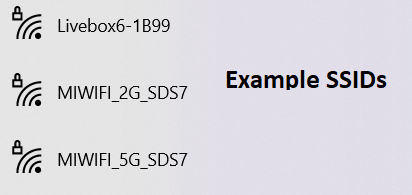Introduction to WAPs
Introduction to WAPs
A Wireless Access Point (WAP) is a networking device used to enable wireless connectivity within a local area network (LAN) or to extend an existing wired network’s coverage.
WAPs play a crucial role in providing Wi-Fi access to devices such as smartphones, laptops, tablets, and IoT devices, allowing them to connect to the internet and communicate with other devices on the network.
WAPs provide the following features:
- Wireless Connectivity
- SSID (Service Set Identifier)
- Encryption
- Authentication
- Multiple Bands
SSID (Service Set Identifier)
SSID (Service Set Identifier)
Each WAP has a unique SSID, which is the network’s name. Users can identify and select the network they want to join based on its SSID.

Security
Security
Authentication
Users connecting to a WAP may need to provide a password or other credentials to access the network. This authentication helps ensure that only authorized users can connect.
Encryption
WAPs typically support encryption protocols such as WPA (Wi-Fi Protected Access) and WPA2/WPA3 to secure wireless communications, preventing unauthorized access and data interception.
Wireless Bands
Multiple Bands
Many modern WAPs support both the 2.4 GHz and 5 GHz frequency bands, allowing for compatibility with a wide range of devices and reducing interference.
You can use tools like Wifi Analyzer and Scanner to see how much congestion there is on your WAP’s channel and adjust the channel if necessary.
Use cases for WAPs
Use cases for WAPs
Home Networks
In homes, a single WAP is often used to provide wireless internet access to various devices. This setup allows family members or residents to connect their devices to the internet without the need for physical network cables.
Business Networks
Businesses deploy multiple WAPs throughout their premises to provide Wi-Fi access to employees, guests, and IoT devices. Secure and managed WAPs are crucial for maintaining network security and performance.
Public Wi-Fi
WAPs are commonly used in public spaces such as cafes, airports, hotels, and libraries to offer Wi-Fi access to customers and visitors.
Education
Educational institutions use WAPs to provide Wi-Fi access to students, teachers, and staff in classrooms, libraries, and campus areas.
Industrial and IoT Networks
In industrial settings and for IoT deployments, ruggedized WAPs are used to provide wireless connectivity for sensors, machines, and control systems.